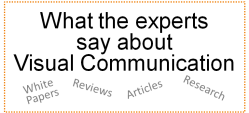We process visuals 60,000 times faster than text – Here’s WHY
Visuals help to increase efficiency and effectiveness of communication. That is nothing new, especially for regular readers of this blog. But did you know that in fact we process visuals 60,000 times faster than text?
Even I was a bit surprised when I saw that number in an article written by Mike Parkinson, founder of Billion Dollar Graphics (BDG), a company that offers organizations and individuals tools to be more successful using effective visual communication. This article titled “The Power of Visual Communication”, can be found on the BDG website together with some other interesting information about visual communication.
What is particularly interesting about this article, compared to the many others we have previously discussed on this blog, is that it takes a closer look at the WHY? question – Why is visual communication so powerful?
There seem to be two main facts about visuals that answer that question.
Firstly, we understand visuals faster because they affect us both cognitively and emotionally.
“Cognitively: Graphics expedite and increase our level of communication. They increase comprehension, recollection, and retention. Visual clues help us decode text and attract attention to information or direct attention increasing the likelihood that the audience will remember.”
“Emotionally: Pictures enhance or affect emotions and attitudes. Graphics engage our imagination and heighten our creative thinking by stimulating other areas of our brain (which in turn leads to a more profound and accurate understanding of the presented material).“
Secondly, we remember visuals better because they are processed in our long-term memory. According to Dr. Lynell Burmark, Ph.D. Associate at the Thornburg Center for Professional Development and writer of several books and papers on visual literacy,
“…unless our words, concepts, ideas are hooked onto an image, they will go in one ear, sail through the brain, and go out the other ear. Words are processed by our short-term memory where we can only retain about 7 bits of information (plus or minus 2) […]. Images, on the other hand, go directly into long-term memory where they are indelibly etched.”
To support this statement Mike uses the following example of a simple circle.
Even with something as simple as a circle it is so much easier to show then describe it. Imagine how much more powerful visuals are for communicating information about more complex items. On top of that visuals are also a universal language which means they are even more effective when communicating with people who speak different languages.
Trackbacks
- Maritz Motivation Solutions Blog 3 Ways to Engage Your Customers Immediately » Maritz Motivation Solutions Blog
- 5 Marketing Ideas for Apartments with Visual Content | Rentping Media
- Why a picture is worth a thousand words
- Tweet it, Blog It, Repeat It, 60,000 Times: Truthiness Achieved - CogDogBlog
- Designing for Mobile Part 3: Visual design - UX Booth | UX Booth





Hi Dave,
I’m doing my thesis on IETM now, and some of it of course involves visual communication. And I have also seen the statement that Visuals are processed 60,000x faster by the brain than text. But I was never able to find the source for this statement. And I ran into this blog, which owner has searched quite a bit after it as well…
I think you should take a look at it:
http://adifference.blogspot.dk/2012/07/60-000-times-faster-than-text-really.html
Cheers,
Jesper
Hi Jesper,
Thank you for sharing this, I have also done some research in this area and came across this blog post late last year. While there is no specific research which quantifies information processing to this value, I have left this blog post up in its original form to encourage conversation (which it appears to have done!) and because it is conceptually not untrue – let me explain.
If you have the time I encourage you to read William Chase & Herbert Simon’s classic Chess Experiment articles from which they developed their ‘chunks’ theory. This research has prompted a huge volume of high quality work by numerous authors to be produced in neuroscience around how the brain stores, recalls and processes information (both textual and visual).
This extended body of knowledge articulates that when information is presented in a way that people can quickly and easily apply to a given situation, their performance is much higher. Read Larkin & Simon (1987) “Why a Diagram is (Sometimes) Worth 10,000 Words” for a good article on this topic. In our context of IETM’s we are frequently dealing with best practice manual labor processes – how to perform an activity safely, to a high standard, and, in a low amount of time. For the trainee, translating a text manual describing this into action is difficult to do. Translating animated 3D models into action is easy. It’s simply mimicking the animation in front of you – that’s how babies learn, anyone can do it!
We are able to act on visual information much faster than textual information as it is readily applied to reality. Do we process visual information around 60,000x faster than text all the time? No, of course not. It’s like saying a picture is worth 10,000 words. There are situations where it is true; and that extraordinary possibility is worth sharing.
I too was stunned at the difference: 60,000 times faster? I too stumbled upon the http://adifference.blogspot.dk/2012/07/60-000-times-faster-than-text-really.html which led me to discredit Mike’s assertion. But using the “Circle” example confirmed that Mike had an agenda, not a discovery. Instead of comparing a description or providing a definition of a circle and comparing it to an image of a circle, had he merely written the word, “circle” I suspect that the results would be different. To make you could say “car” or use 60,000 words to describe in technical details the construction of a car. The results would show that we processed the image millions of times faster.
Images are processed faster but often introduce vagueness to the interpretation. Think of a glass of milk with no descriptive explanation. Are you supposed to think, “milk”? “glass (or cup)”? “glass of milk”?
Larkin took the time to parse out that there is a combination of activities in the learning process, not make an unsupported assertion.